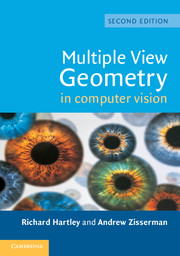Book contents
- Frontmatter
- Contents
- Foreword
- Preface
- 1 Introduction – a Tour of Multiple View Geometry
- PART 0 The Background: Projective Geometry, Transformations and Estimation
- PART I Camera Geometry and Single View Geometry
- PART II Two-View Geometry
- 9 Epipolar Geometry and the Fundamental Matrix
- 10 3D Reconstruction of Cameras and Structure
- 11 Computation of the Fundamental Matrix F
- 12 Structure Computation
- 13 Scene planes and homographies
- 14 Affine Epipolar Geometry
- PART III Three-View Geometry
- PART IV N-View Geometry
- PART V Appendices
- Bibliography
- Index
14 - Affine Epipolar Geometry
Published online by Cambridge University Press: 25 January 2011
- Frontmatter
- Contents
- Foreword
- Preface
- 1 Introduction – a Tour of Multiple View Geometry
- PART 0 The Background: Projective Geometry, Transformations and Estimation
- PART I Camera Geometry and Single View Geometry
- PART II Two-View Geometry
- 9 Epipolar Geometry and the Fundamental Matrix
- 10 3D Reconstruction of Cameras and Structure
- 11 Computation of the Fundamental Matrix F
- 12 Structure Computation
- 13 Scene planes and homographies
- 14 Affine Epipolar Geometry
- PART III Three-View Geometry
- PART IV N-View Geometry
- PART V Appendices
- Bibliography
- Index
Summary
This chapter recapitulates the developments and objectives of the previous chapters on two-view geometry, but here with affine cameras replacing projective cameras. The affine camera is an extremely usable and well conditioned approximation in many practical situations. Its great advantage is that, because of its linearity, many of the optimal algorithms can be implemented by linear algebra (matrix inverses, SVD etc.), whereas in the projective case solutions either involve high order polynomials (such as for triangulation) or are only possible by numerical minimization (such as in the Gold Standard estimation of F).
We first describe properties of the epipolar geometry of two affine cameras, and its optimal computation from point correspondences. This is followed by triangulation, and affine reconstruction. Finally the ambiguities in reconstruction that result from parallel projection are sketched, and the non-ambiguous motion parameters are computed from the epipolar geometry.
Affine epipolar geometry
In many respects the epipolar geometry of two affine cameras is identical to that of two perspective cameras, for example a point in one view defines an epipolar line in the other view, and the pencil of such epipolar lines intersect at the epipole. The difference is that because the cameras are affine their centres are at infinity, and there is parallel projection from scene to image. This leads to certain simplifications in the affine epipolar geometry:
Epipolar lines. Consider two points, x1, x2, in the first view. These points backproject to rays which are parallel in 3-space, since all projection rays are parallel.
- Type
- Chapter
- Information
- Multiple View Geometry in Computer Vision , pp. 344 - 362Publisher: Cambridge University PressPrint publication year: 2004
- 1
- Cited by



